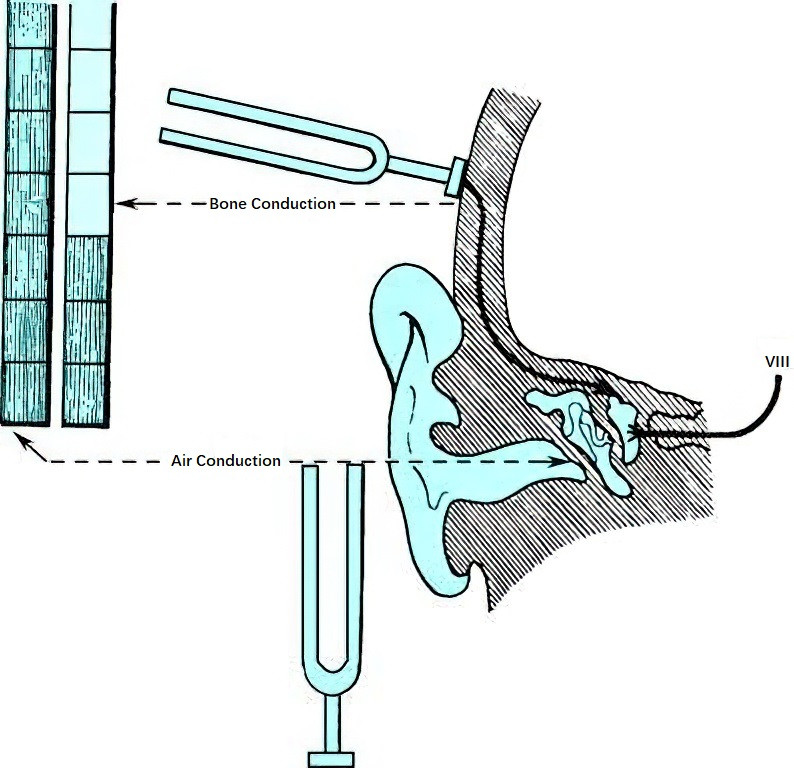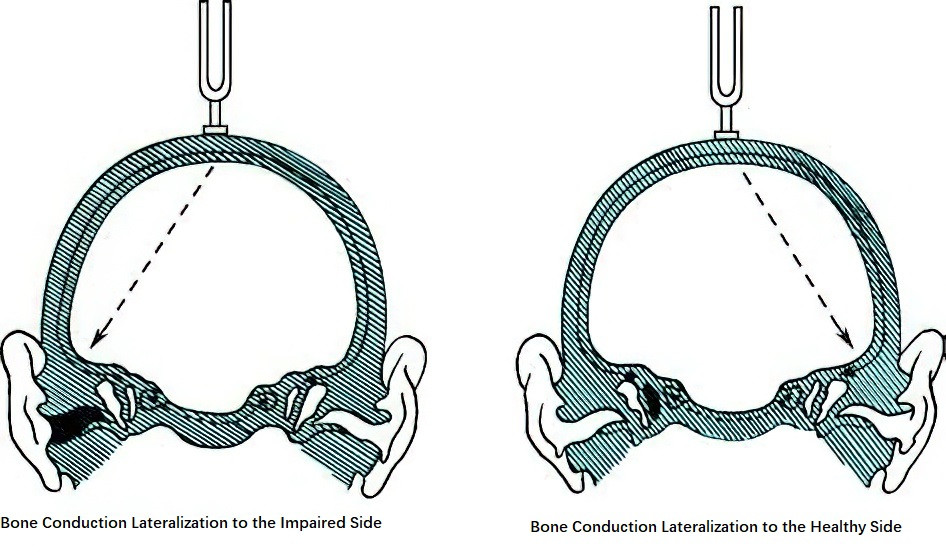The tuning fork test is one of the most commonly used subjective hearing assessments in outpatient clinics. It is used for the preliminary diagnosis of hearing impairments, differentiation between conductive and sensorineural hearing loss, and validation of audiometry results. However, it cannot accurately determine the degree of hearing loss. The tuning fork is made of steel or alloy materials, consisting of two vibrating arms (fork arms) and a fork handle. A standard set includes five octave-frequency tuning forks: C128, C256, C512, C1024, and C2048, each producing a pure tone of a specific frequency. The most commonly used frequencies are C256 and C512.
When air conduction (AC) hearing is assessed, the examiner holds the fork handle and strikes the tuning fork's arms against the thenar muscle of the opposite palm (avoiding excessive force to prevent harmonic overtones). The vibrating ends of the two fork arms are then positioned 1 cm away from the ear canal opening in alignment. When bone conduction (BC) hearing is assessed, the base of the fork handle is pressed against the skull's bony surfaces or the mastoid process.
Rinne Test
The Rinne test (RT), also known as the air and bone conduction comparison test, is used to determine the nature of hearing loss by comparing the air and bone conduction hearing times of the same ear. Bone conduction is tested first, and once the tuning fork sound is no longer audible, air conduction is immediately tested on the same side. Alternatively, air conduction can be tested first, followed by bone conduction in the same ear.
- Air conduction time greater than bone conduction time (AC > BC) is considered positive (+).
- Bone conduction time greater than air conduction time (BC > AC) is considered negative (-).
- Equal air and bone conduction times (AC = BC) are indicated as "(±)".
In individuals with normal hearing, air conduction time is longer than bone conduction time, with the duration for AC typically being about twice as long as BC when using the C256 tuning fork.
- A positive result (+) indicates normal hearing or sensorineural hearing loss.
- A negative result (-) indicates conductive hearing loss.
- A result of "(±)" indicates mild-to-moderate conductive hearing loss or mixed hearing loss.

Figure 1 Rinne test
Positive (AC > BC): Normal hearing or sensorineural hearing loss.
A continuous air and bone conduction comparison test can be used to determine whether stapes footplate fixation is present in patients with otosclerosis. In cases of complete stapes footplate fixation, all octave-frequency tuning forks will show a negative (-) result.
Weber Test
The Weber test (WT), also known as the bone conduction lateralization test, is used to compare the bone conduction hearing of both ears. The examiner uses a C256 or C512 tuning fork, striking it and then firmly pressing the base of the fork handle on the midline of the skull (commonly the forehead or chin). The patient is asked to report the side to which the bone-conducted sound is lateralized, marked as "→" for the affected side or "→" for the unaffected side. Equal perception on both sides is marked as "=".
- A result of "=" indicates normal hearing or an equal degree of hearing loss in both ears.
- Lateralization to the impaired ear indicates conductive hearing loss in the affected ear.
- Lateralization to the healthier ear indicates sensorineural hearing loss in the affected ear.

Figure 2 Weber test
Schwabach Test
The Schwabach test (ST), also known as the bone conduction comparison test, compares the bone conduction hearing of the patient to that of a normal individual (usually the examiner). The tuning fork is used to determine whether the patient's bone conduction persists after the examiner can no longer hear it, and vice versa.
- Prolonged bone conduction compared to normal is indicated as (+).
- Shortened bone conduction compared to normal is indicated as (-).
- Similar bone conduction times are indicated as "(±)".
- A result of (+) suggests conductive hearing loss.
- A result of (-) indicates sensorineural hearing loss.
- A result of "(±)" indicates normal hearing.
Comparative results from the tuning fork tests for conductive and sensorineural hearing loss are summarized in Table 1.

Table 1 Comparison of tuning fork test results
Gelle Test
The Gelle test (GT) evaluates the mobility of the stapes footplate. By applying alternating positive and negative pressure to the external auditory canal using a pneumatic otoscope, and simultaneously pressing the base of a vibrating tuning fork onto the mastoid process, this test assesses changes in sound intensity perceived by the patient.
- If the stapes is mobile, the patient will perceive changes in tuning fork sound intensity corresponding to pressure changes, which indicates a positive result.
- In cases of otosclerosis or ossicular chain fixation, no changes in sound intensity are perceived, resulting in a negative result.